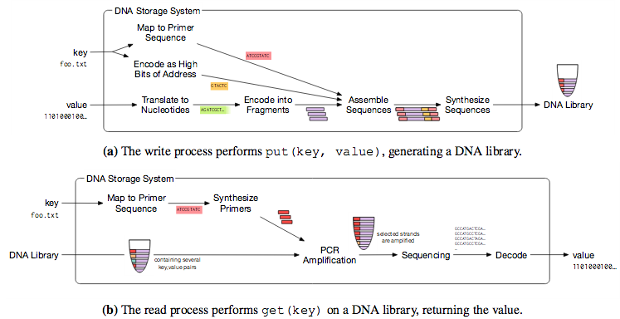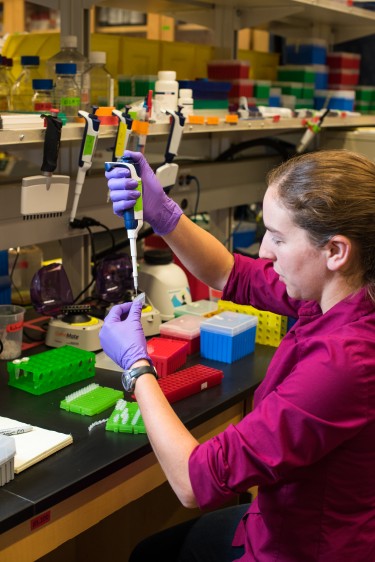Scientists were able to successfully save images in DNA and read them.
The total amount of stored information - 151 KB

In the DNA sample in the pipette (pink trace) you can store about 9 TB of data
Employees of the Microsoft research unit and a team of scientists from the University of Washington were able to successfully store a number of images into DNA , and then read this information without error. In total, four graphic files were used in the work, the size of which ranged from 5 to 24 KB. Experts published preliminary results of their work in ASPLOS .
')
Why was DNA chosen as a carrier of information? The fact is that the data recording here can be conducted with very high density. According to preliminary calculations, the data exabyte can be stored in the volume of a cubic millimeter. In addition, DNA is the “long-liver” in the world of information carriers. Data retention on such media is 500 years or more. True, the process of reading and writing is technically complicated and expensive, but over time these two problems can be solved.

The process of writing and reading information using DNA
Now the question of finding new types of media is more urgent than ever. The digital universe is expanding rapidly, and by 2020, scientists predict an increase in the total amount of information stored by mankind to 44 trillion gigabytes. Not all information generated by man can be called useful and necessary, but it takes up space. Moreover, information is generated faster than media are produced.

Lee Organic, a member of the research team, is preparing a mixture of DNA samples for recording information. In each test tube there may be a cat or a Tchaikovsky symphony (source: Tara Brown Photography / University of Washington)
DNA molecules can store information for hundreds of years, as mentioned above, and the data recording density is tens of thousands of times higher than in the case of conventional SSDs, hard drives, optical drives. Moreover, all this "iron" comes into disrepair much faster than DNA.
A team of scientists has developed a way to record sequences of ones and zeros using blocks of DNA sequences - adenine, guanine, cytosine, and thymine. The storage unit is a sequence of about 200 nucleotides, with a volume of information of 50-100 bits. For storing large amounts of data using a variety of fragments, collected in a single pool. The architecture used for storage is a key value. And as a key to obtain data, primers are used for polymerase chain reaction. These primers point to those DNA fragments where the recorded information is stored.

It should be noted that when using the technology of recording information on DNA errors are possible, their probability is not so small - about a percent. Therefore, scientists worked with a modified Goldman coding . This type of record allows you to restore the third DNA fragment in any two other fragments. Thus, a “margin of safety” is introduced into such a system, such a principle of data storage uses redundancy to increase the accuracy of reading information. You can store any information, including text, images, videos.
In total, 45652 sequences of 120 nucleotides were involved in the process of writing / reading.

In the DNA sample in the pipette (pink trace) you can store about 9 TB of data
Employees of the Microsoft research unit and a team of scientists from the University of Washington were able to successfully store a number of images into DNA , and then read this information without error. In total, four graphic files were used in the work, the size of which ranged from 5 to 24 KB. Experts published preliminary results of their work in ASPLOS .
')
Why was DNA chosen as a carrier of information? The fact is that the data recording here can be conducted with very high density. According to preliminary calculations, the data exabyte can be stored in the volume of a cubic millimeter. In addition, DNA is the “long-liver” in the world of information carriers. Data retention on such media is 500 years or more. True, the process of reading and writing is technically complicated and expensive, but over time these two problems can be solved.

The process of writing and reading information using DNA
Now the question of finding new types of media is more urgent than ever. The digital universe is expanding rapidly, and by 2020, scientists predict an increase in the total amount of information stored by mankind to 44 trillion gigabytes. Not all information generated by man can be called useful and necessary, but it takes up space. Moreover, information is generated faster than media are produced.

Lee Organic, a member of the research team, is preparing a mixture of DNA samples for recording information. In each test tube there may be a cat or a Tchaikovsky symphony (source: Tara Brown Photography / University of Washington)
DNA molecules can store information for hundreds of years, as mentioned above, and the data recording density is tens of thousands of times higher than in the case of conventional SSDs, hard drives, optical drives. Moreover, all this "iron" comes into disrepair much faster than DNA.
A team of scientists has developed a way to record sequences of ones and zeros using blocks of DNA sequences - adenine, guanine, cytosine, and thymine. The storage unit is a sequence of about 200 nucleotides, with a volume of information of 50-100 bits. For storing large amounts of data using a variety of fragments, collected in a single pool. The architecture used for storage is a key value. And as a key to obtain data, primers are used for polymerase chain reaction. These primers point to those DNA fragments where the recorded information is stored.

It should be noted that when using the technology of recording information on DNA errors are possible, their probability is not so small - about a percent. Therefore, scientists worked with a modified Goldman coding . This type of record allows you to restore the third DNA fragment in any two other fragments. Thus, a “margin of safety” is introduced into such a system, such a principle of data storage uses redundancy to increase the accuracy of reading information. You can store any information, including text, images, videos.
In total, 45652 sequences of 120 nucleotides were involved in the process of writing / reading.
Source: https://habr.com/ru/post/368679/
All Articles